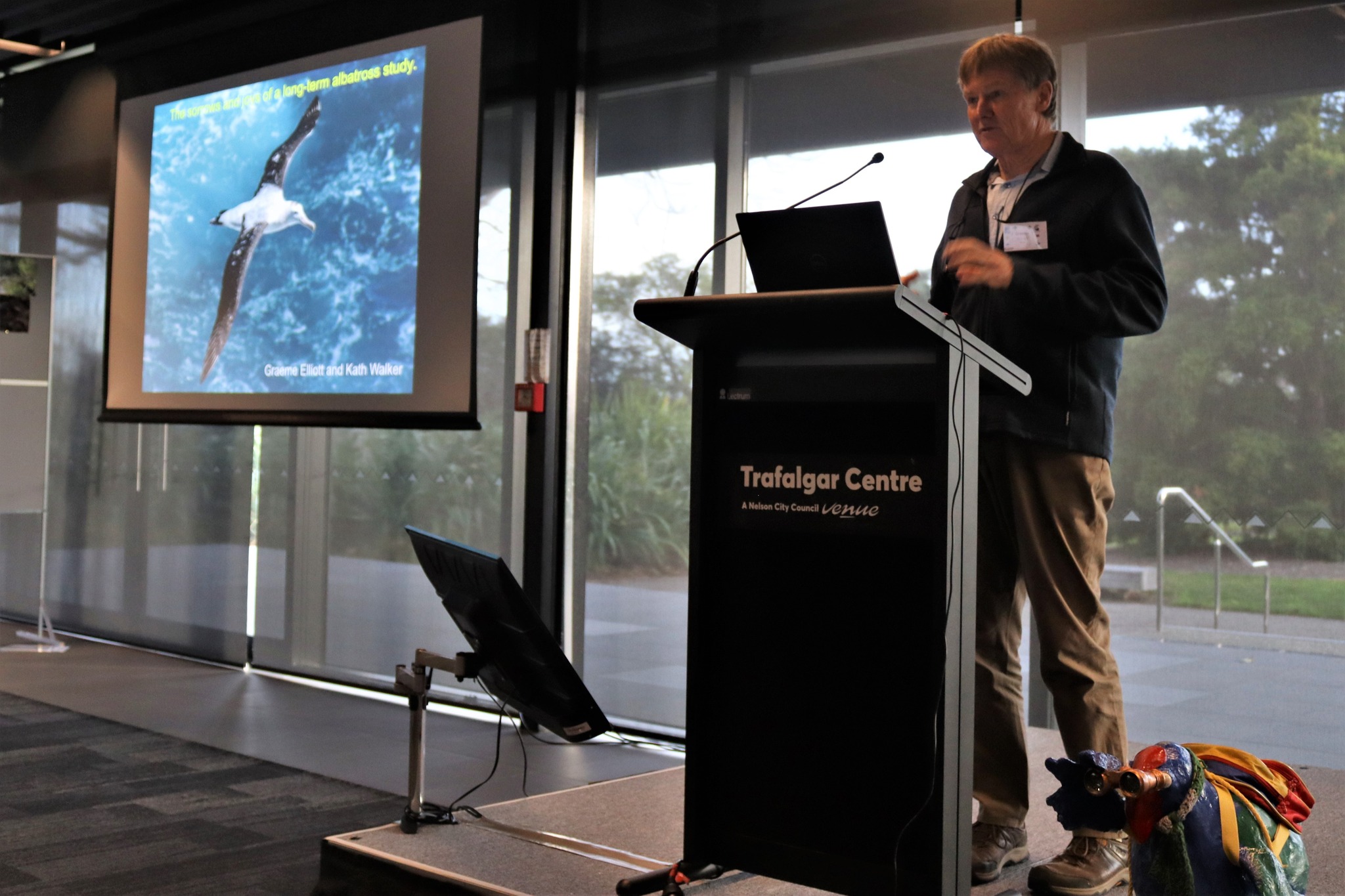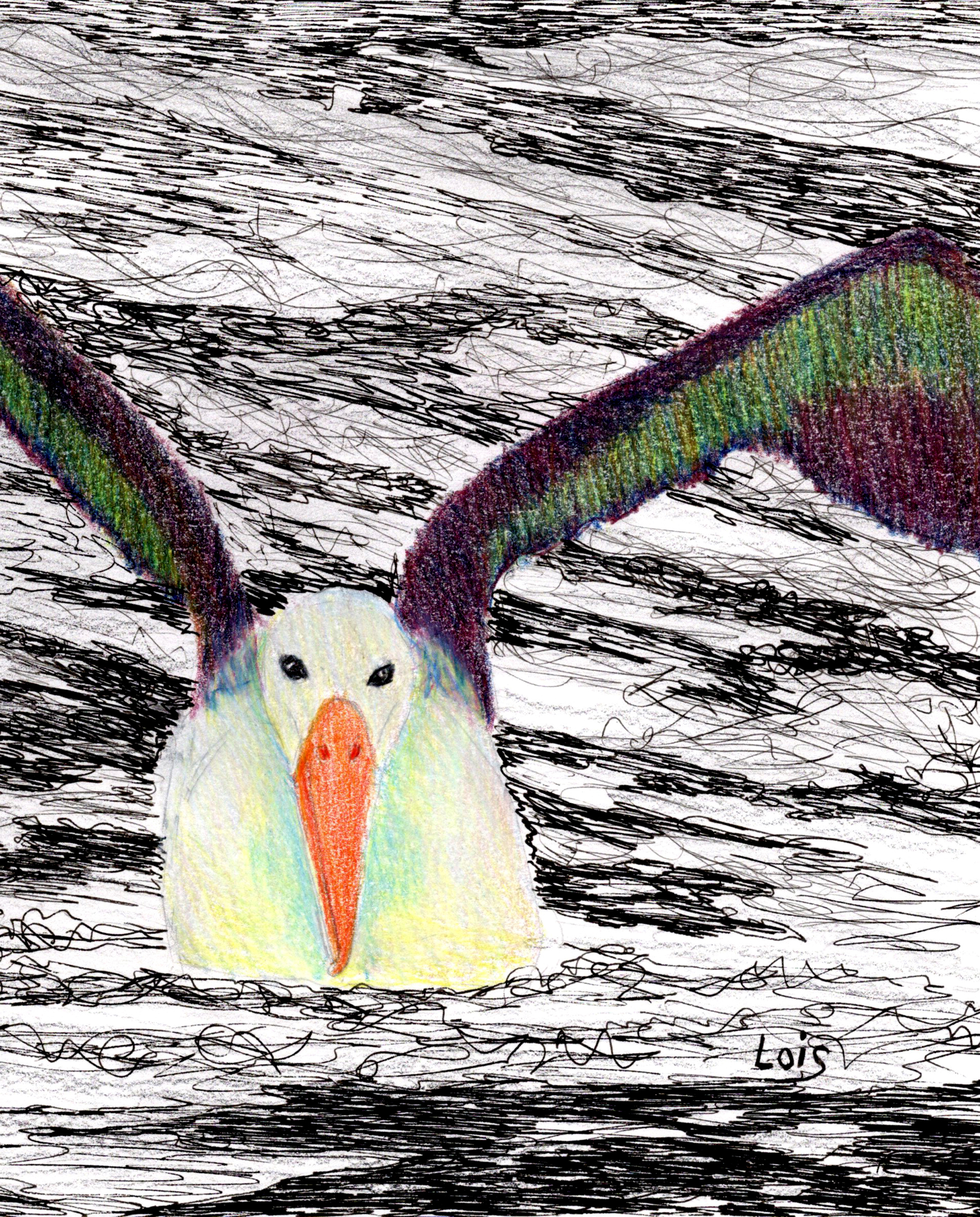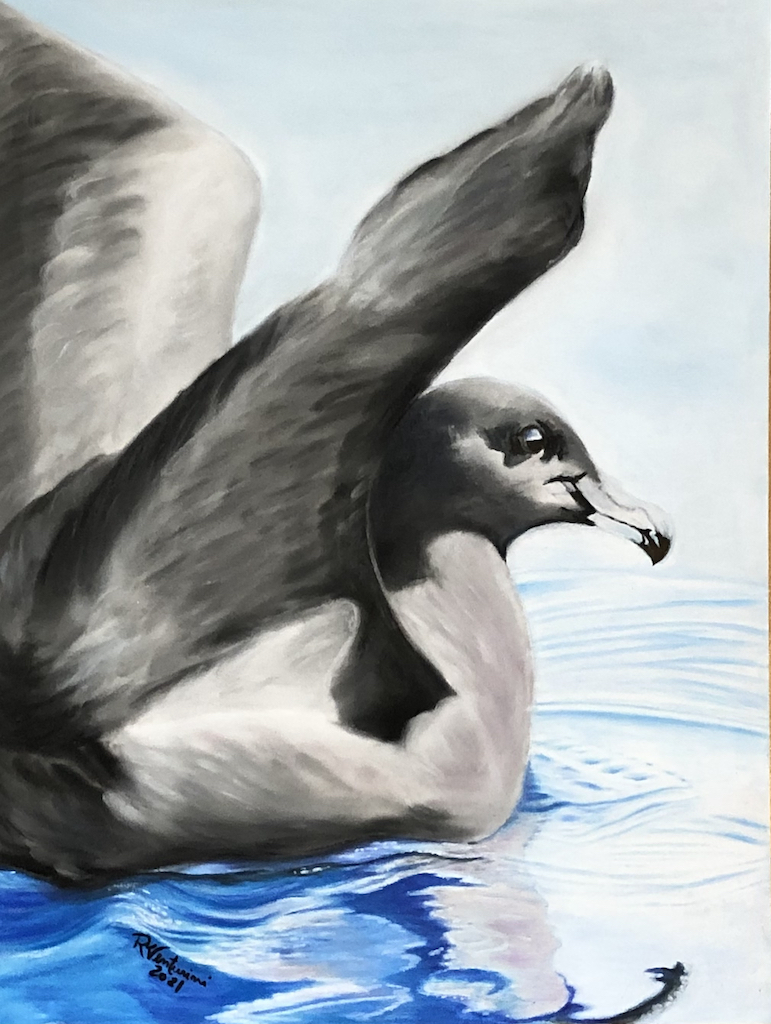
Graeme Elliott delivers a paper on a long-term study of Antipodean Albatrosses
The 2024 Birds New Zealand Annual Conference was held in Nelson, South Island from 1-2 June. Several talks and posters were given on procellariiform seabirds. Four abstracts on ACAP-listed species follow. See an earlier article in ACAP Latest News on two presentations at the conference on the subspecies of Antipodean Albatrosses Diomedea antipodensis.
Graeme Elliott OZNM and Kath Walker OZNM talk is entitled ‘33 years of monitoring wandering albatrosses on Antipodes and Adams Islands’. Their abstract follows:
“Monitoring of Gibson’s wandering albatrosses on Adams Island started in 1991 and an almost identical programme of monitoring of Antipodean wandering albatrosses started on Antipodes Island in 1994. Both programmes have continued annually, except for one missed year on each island. Both programmes have involved estimating survival by banding and re-sighting birds, monitoring nesting success, tracking birds at sea using satellite and geolocator tags, estimating the size of the population by undertaking whole island censuses, and tracking population change by annual counting of nesting birds in representative portions of the islands. Both populations increased up until 2005 but then crashed with numbers continuing to fall for about 15 years, until Antipodean albatrosses were about 42% and Gibson’s about 47% of their pre-crash levels. Satellite and geolocator tracking of both taxa have enabled accurate description of their foraging ranges and identified that a large number of birds have been killed by tuna long-liners, particularly in the waters to the northeast of New Zealand. Tracking has revealed that although their foraging ranges overlap, Gibson’s mostly forage in the Tasman Sea while Antipodean mostly forage in the eastern Pacific. Such long-term monitoring programmes have involved half of our lives’ summers and several hundred days of sea-sickness, but we now know exactly what the two albatross populations are doing in good detail and we’ve had the joy of interacting with a wide range of rarely seen subantarctic birds.”

Black-browed Albatross by Lois Davis, Artists and Biologists Unite for Nature for ACAP
Jonathan Rutter and colleagues presented on “Immersion regularity predicts vessel following by albatrosses”. Their abstract follows:
“Many oceanic seabird species are threatened by bycatch in fisheries. Bycatch risk assessments benefit from quantifying individual seabird interactions with fishing vessels, including their frequency, duration, and impacts on seabird behaviour. However, interaction analyses are often limited by low-resolution seabird tracking data and incomplete fisheries tracking data. Here we examine the potential of leg-borne GLS-immersion loggers to detect seabird-fishery interactions from simple wet-dry patterns when tracking data are lacking or incomplete. We first identified 46 discrete seabird-vessel interactions by spatiotemporally matching high-resolution GPS data (0.0024-1 Hz) from 45 black-browed albatrosses (Thalassarche melanophris) breeding in the Falkland Islands to Automatic Identification System (AIS) data from vessels near their trajectories. We subsequently observed highly stereotypical patterns of immersion (i.e., regular landing and taking off) when birds were following trawler vessels. Then, using only wet and dry durations derived from immersion data (0.1667 Hz), we developed a temporal metric to identify these periods of behavioural regularity. This metric alone successfully identified one-third of vessel following events, with no false positive detections. Thus, we demonstrate the potential of immersion loggers to detect vessel following by seabirds, even in the absence of tracking data for both seabirds and vessels. This result provides a foundation for more comprehensive seabird bycatch risk assessments that quantify previously hidden seabird-vessel interactions, such as those involving migratory life history stages and illegal, unreported, or unregulated (IUU) fishing vessels.”

“Towards understanding tākoketai/Black Petrel recruitment on Aotea/Great Barrier Island” delivered by Elizabeth ‘Biz’ Bell
Biz and her co-authors’ abstract follows:
“Monitoring of tākoketai/black petrels (Procellaria parkinsoni) has been undertaken at their breeding colony on Hirakimata/Mt Hobson, Aotea/Great Barrier Island since 1995. Over this period, the population trend suggests a stable or slightly declining population, which appears to be related to low juvenile survival and recruitment into the population. As these low rates may be related to recapture effort at the colony, recent expeditions focused on increased nocturnal surveys to capture as many tākoketai on the surface as possible, as well as capturing individuals at-sea. Comparison between on-land and at-sea ‘returned chick’ recapture rates indicate that on-land effort is more effective in resighting ‘returned chicks’. Over 28 years of tākoketai monitoring on Aotea, 141 ‘returned chicks’ have been recaptured over 228 night surveys with an average 0.62 returned chicks caught each night. The recent focused effort in 2021/2022 and 2022/2023 (22 nights surveys) increased that rate to an average of 2.3 returned chicks recaptured per night. In comparison, from six at-sea capture expeditions extending over three years and 15 days cumulatively, 3 tākoketai originally banded as chicks were recaptured (average 0.2 per day). Continued effort to recapture ‘returned chicks’ at the Hirakimata study colony is recommended to enhance population trend models and risk analyses”.

Black Petrel, PanPastels by Rosana Venturini, Artists and Biologists Unite for Nature for ACAP
Maria Düssler and colleagues gave a talk entitled “Comparative study of the diving behaviour of three Procellaria petrel species”. Their abstract follows.
“The ongoing impact of fishery bycatch on seabird populations suggests bycatch mitigation measures are insufficient or ill-informed. For these measures to be appropriately revised, a thorough understanding of seabird foraging behaviour is necessary. My thesis aims to examine and compare the foraging behaviour of three Procellaria petrel species, all of which are vulnerable to bycatch in longline fisheries. Using data from time-depth recorders (TDRs) deployed on 23 Westland (Procellaria westlandica), 10 white-chinned (P. aequinoctialis), and 9 black petrels (P. parkinsoni), we retrieved dive depths, durations, descent rates, and dive profiles. Preliminary results show white-chinned petrels dive less frequently but deeper than Westland petrels, with maximum depths of 17.31 m and 21.72 m, respectively. Further results will have the potential to inform the necessary sink rates of hooks and the depths to which hooks must be protected. Additionally, we deployed global positioning system (GPS) tags alongside the TDRs on 7 black petrels. Pairing GPS data from birds and fishing vessels will allow us to investigate whether petrel diving behaviour differs around fishing vessels. Should behaviours differ, previous mitigation measures based on undefined diving behaviour may need to be revised. By employing a comparative approach across three species, we begin to understand potential parameters influencing the foraging behaviour, and thus the bycatch risk, of different seabird species.”
A number of talks and posters were given on other procellariiform seabirds not listed by ACAP. Information comes from the Facebook page and website of Birds New Zealand.
John Cooper, Emeritus Information Officer, Agreement on the Conservation of Albatrosses and Petrels, 02 July 2024

 English
English  Français
Français  Español
Español